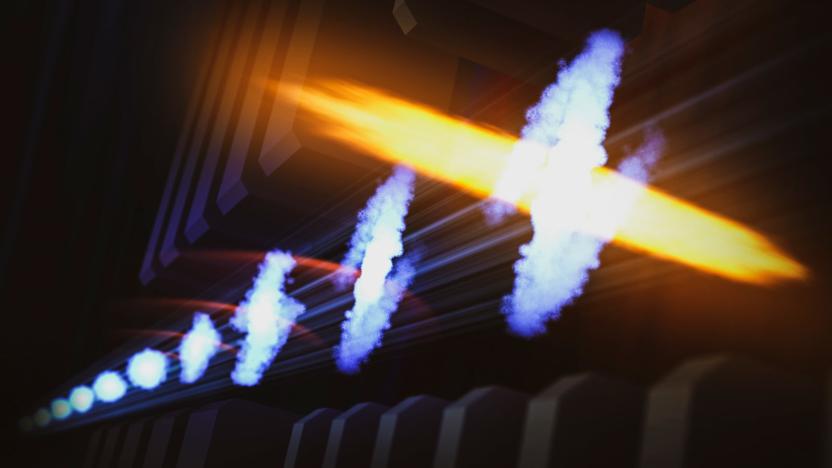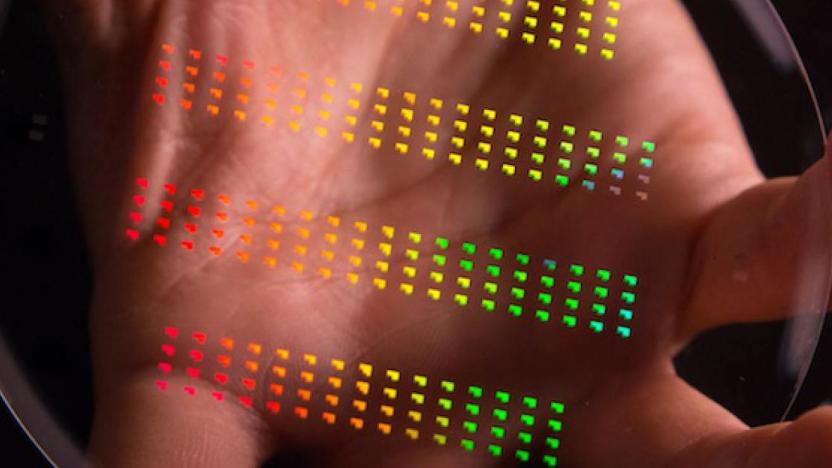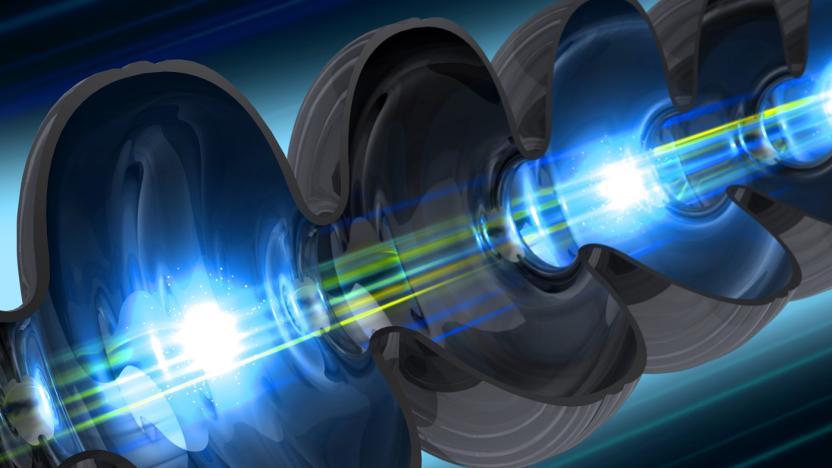SLAC National Accelerator Laboratory
Latest

X-ray lasers can spot elusive electron motion
Scientists can track the movements of an atom's nucleus relatively easily, but electrons have proven elusive -- they move so fast that they tend to be reduced to blurs. Now, however, those movements could be crystal clear. Researchers at the SLAC National Accelerator Lab have developed a technique, X-ray laser-enhanced attosecond pulse generation (XLEAP), that can observe even the fastest motions of electrons. The laser pulses at just 280 attoseconds, or billionths of a billionth of a second, and can create snapshots of electrons to track their progress. The trick was to modify the laser in a way that squeezed electrons into tighter groups, making for shorter X-ray bursts.

Physicists keep striking out in the search for dark matter
Space may be the final frontier, but we've barely begun to explore its underlying mechanics. For as much as humanity has discovered since we first looked to the heavens, we've only seen about five percent of the total matter in the universe. The other 95 percent -- the so-called "dark matter" -- well, we can't even figure out how to see yet. But that doesn't mean researchers from around the world aren't devising ways to do so.

Stanford’s ‘accelerator on a chip’ could revolutionize medical care
When the SLAC National Accelerator Laboratory at Stanford first opened its doors in 1966, it had already earned the distinction of housing the world's longest linear accelerator: A 3.2 kilometer monstrosity buried 25 feet under the gently rolling hills of Northern California. Today the lab, along with an international consortium of research organizations, is working to create a new kind of accelerator -- one small enough to fit in a shoebox but offering huge scientific potential.

World's most powerful X-ray laser will get 10,000 times brighter
If you think that Stanford's use of an super-bright X-ray laser to study the atom-level world is impressive, you're in for a treat. The school and its partners have started work on an upgrade, LCLS-II (Linac Coherent Light Source II), whose second laser beam will typically be 10,000 times brighter and 8,000 times faster than the first -- up to a million pulses per second. The feat will require an extremely cold (-456F), niobium-based superconducting accelerator cavity that conducts electricity with zero losses. In contrast, the original laser shoots through room-temperature copper at a relatively pedestrian 120 pulses per second.

Scientists use lasers to understand how water stays liquid below its freezing point
We only remember a few things from science 101, but we're reasonably certain that water boils at 212 degrees (Fahrenheit) and freezes at 32. Scientists at Stanford's SLAC National Accelerator Laboratory, armed with a Linac Coherent Light Source X-Ray Laser, however, have shown us otherwise. Should you be armed with such a device, the normal rules of physics no longer apply, and -- for the first time -- it becomes possible to observe water right down to its molecular level, even while it is supercooled as a liquid to minus 52 degrees Fahrenheit.

Diamond hones DOE X-ray laser howitzer to razor-sharp precision
The US Department of Energy's SLAC accelerator lab already has a pretty useful X-ray laser -- the Linac Coherent Light Source (LCLS). But, recent modifications to the device have scientists drooling over its new found potential. Using a thin wafer of diamond, the Stanford-run lab filtered the beam to a lone frequency, then amplified it in a process called "self-seeding." That's given the world's most powerful X-ray laser even more punch by tossing out unneeded wavelengths which were reducing its intensity. The tweaks allow scientists across many fields to finesse and image matter at the atomic level, giving them more power to study and change it. According to the lab, researchers who came to observe the experiment from other X-ray laser facilities "were grinning from ear to ear" at the possibility of integrating the tech into their own labs. The SLAC team claims they could still add 10 times more punch to the LCLS with further optimization, putting the laser in a class by itself -- X-ray-wise, anyway.

X-ray laser bakes solid plasma from aluminum foil, brings us closer to nuclear fusion
Nuclear fusion, like flying cars, is one of those transparent, dangling carrots that've been stymying the scientific community and tickling our collective noses for decades. But recent research out of the Department of Energy's SLAC National Accelerator Laboratory might help us inch a few baby steps closer to that Jetsonian future. The experiment, conducted by a group of Oxford University scientists, utilized the DOE's Linac Coherent Light Source -- an X-ray laser capable of pulsing "more than a billion times brighter" than current synchrotron sources -- to transmute a piece of aluminum foil heated to 3.6 million degrees Fahrenheit (or 2 million degrees Celsius) into a cube of solid plasma. So, why go to such lengths to fry a tiny piece of metal at that extreme temperature? Simple: to replicate conditions found within stars and planets. Alright, so it's not that easy and we're still a ways off from actually duping celestial bodies, but the findings could help advance theories in the field and eventually unlock the powers of the Sun. Until that fateful day arrives, however, we'll just have to let these pedigreed pyros continue to play with their high-tech toys.




